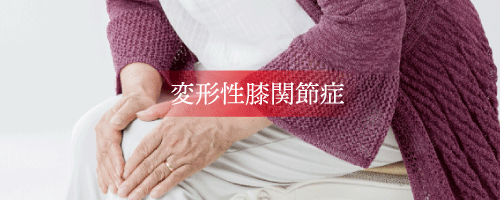
Osteoarthritis of the knee is a condition in which the cartilage that cushions the joint wears down due to aging or a decrease in muscle mass, leading to pain. As the cartilage wears down, the gap between the bones in the knee joint narrows, exposing the inner bone, and bony spurs or deformities can form at the edges of the bone.
The knee is said to bear 2.3 times the body weight, making it particularly prone to strain and damage. Additionally, it is the most complex and unstable structure in the human body, functioning as the pivot for movement.
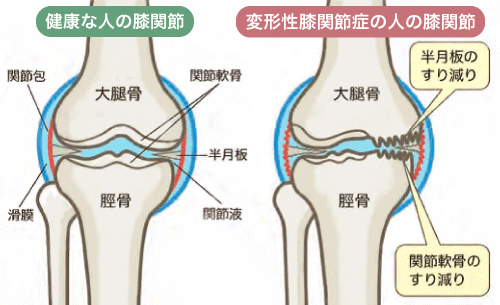
With the aging society, degenerative diseases based on age-related changes are increasing. Osteoarthritis (OA) is one of the most common orthopedic conditions seen in outpatient clinics.
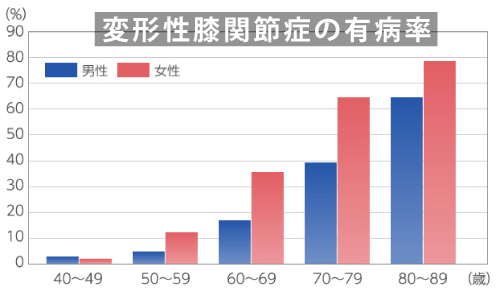
The male-to-female ratio is 1:4, with women being significantly more likely to develop the condition, especially women over 40 who are overweight.
The frequency of osteoarthritis is increasing year by year, and about 80% of people over 60 are said to have some form of osteoarthritis seen on X-rays. Osteoarthritis of the knee is the most common type of OA, and if it progresses, it can lead to pain while walking and significantly impact daily activities.
Osteoarthritis of the knee is classified into “primary” (without clear cause) and “secondary” (with a clear cause such as illness or injury). The majority of cases are “primary.” Osteoarthritis develops from a combination of various factors, and there are many risk factors related to its onset and progression.
“Primary” osteoarthritis is caused by the wear and tear of knee cartilage with aging, and factors like obesity are related. “Secondary” osteoarthritis is caused by various factors, with trauma being the most common cause.
It is difficult to clearly separate these factors, as they closely influence each other and contribute to the formation of the disease.
Degenerative changes in joint cartilage (due to aging) and mechanical stimulation from load and joint movement lead to joint deformation and proliferative changes due to friction. However, this can also occur due to factors such as obesity, arteriosclerosis, activation of cartilage-degrading enzymes, and hormonal influences.
The main symptoms of osteoarthritis of the knee are pain and swelling in the knee. Fluid (synovial fluid) may accumulate in the joint.
Osteoarthritis of the knee progresses gradually over time, and the symptoms worsen slowly. Let’s look at the progression of osteoarthritis of the knee in three stages.

In the early stage, there is pain (pain during movement) when standing up or walking, but the pain usually subsides after resting.
In the middle stage, the frequency of pain during movement increases, and actions such as sitting on the floor, squatting, and going up or down stairs become difficult. The range of motion of the knee becomes limited (range of motion restriction).
In the late stage, the knee becomes unable to fully straighten, and walking becomes difficult. Daily activities become impaired. Additionally, joint deformities become visible, and bow-legged deformities (O-legs) occur.
As we can see, knee pain gradually worsens in stages. The stiffness, discomfort, or pain in the knee could be early symptoms of osteoarthritis of the knee.
Diagnosis is made through a combination of patient history, physical examination, sometimes palpation for tenderness on the inner side of the knee, checking the range of joint movement, swelling, and deformities like O-legs. X-ray (radiography) is used for diagnosis, and MRI may be performed if needed.
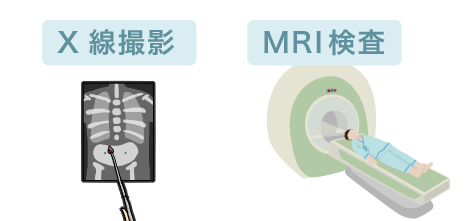
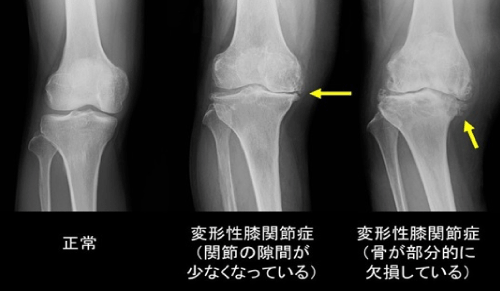
X-ray (radiography) is used to observe the state of the knee joint, typically taken while standing. In osteoarthritis of the knee, X-ray images may show “subchondral sclerosis” (hardening of the bone beneath the cartilage), “joint space narrowing,” and “osteophytes” (spurs of bone).
The goal of treatment for osteoarthritis of the knee is to relieve pain, improve knee joint function, and prevent a decline in daily activities. Treatment is divided into “conservative therapy” and “surgical therapy.” Regardless of the stage, conservative therapy is initially performed. If conservative therapy does not relieve pain and daily activities are impaired, surgical therapy is considered.
Conservative therapy is based on “lifestyle guidance,” and combines “exercise therapy,” “drug therapy,” and “brace therapy.”
When knee pain leads to inactivity, muscle strength that supports the knee decreases, which can lead to weight gain. As a result, the load on the knee increases, worsening the pain. As the basis of conservative therapy, lifestyle guidance focuses on exercise, weight loss, and diet.
Exercise therapy is aimed at strengthening the muscles around the knee joint to reduce the burden on the knee. Exercises like SLR (Straight Leg Raise) focus on training the quadriceps muscle at the front of the thigh.
Drug therapy for osteoarthritis of the knee includes “oral medications,” “topical medications,” and “intra-articular injections.”
Braces and supports that reduce the burden on the knee and stabilize the joint include foot orthotics, functional knee braces, knee supports, and walking aids like canes.
If conservative therapy does not provide sufficient relief and daily life is impaired, surgical therapy is considered. The main surgeries for osteoarthritis of the knee include “arthroscopic surgery (arthroscopic debridement),” “high tibial osteotomy,” and “total knee arthroplasty.”
For inflammation, pain relief, and improving blood circulation around the knee joint, treatments are applied when there are tender points or joint effusion around the knee.
[Prescription Example] Liangqiu (梁丘), Xuehai, Weizhong, Hegu, Gai Ge (外隙), Nei Ge (内隙)
For joint effusion: Liangqiu, Xuehai, Nei Xiya, Gai Xiya for moxibustion.
If the treatment still feels ineffective, consider consulting a professional.
© Copyright (C) All Rights Reserved..